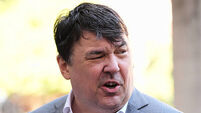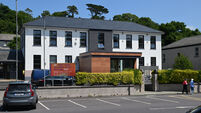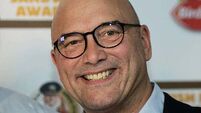Jan Harlan remembers Stanley Kubrick and their time in Ireland

GERMAN film producer Jan Harlan is the younger brother of Stanley Kubrick’s widow, Christiane Kubrick. He first met Kubrick in the late 1950s, but the film director didn’t make much of an impression on him. Harlan was at school at the time. “I had no interest in him other than that he happened to be the man of my sister,” he says.

Little did Harlan realise the impact Kubrick would have on his life. He became Kubrick’s confidante. The pair met or spoke on the phone for nearly every day for 30 years until Kubrick passed away in 1999.
Harlan likes to say he only had the measure of Kubrick when it came to table tennis and music. He suggested a piece of music that Kubrick used for 2001: A Space Odyssey, and began working regularly for him as a researcher on Kubrick’s aborted biopic, Napoleon, and later as an executive producer on his films. These included Barry Lyndon, which will be screened at the Jameson Dublin International Film Festival to mark its 40th anniversary.
Much of Barry Lyndon — which is an adaptation of William Thackeray’s novel about an 18th century rogue, and starred Ryan O’Neal and Vogue model Marisa Berenson — was shot on location in Ireland.

“Ireland has these old ruins, these castles — Thomastown, Carrick-on-Suir — and this landscape, which has a special flavour that is absolutely unsurpassed,” says Harlan. “In England, you have these stately homes but you don’t have the type of stately homes that you have in Ireland. There is a certain seediness about them that is just wonderful. Also the story takes place in Ireland. He was an Irish guy — this Barry Lyndon. Stanley wanted to get this right, and he succeeded.
“Most cinemagoers don’t care, but those who do realise how precious these shots in Barry Lyndon are — how carefully they are composed, and how carefully the locations are chosen. The whole film was shot on location. We only used a studio in Bray for one scene — an interior set with the military.”
Kubrick’s eye for detail went as far as using real clothing gathered from museums. “They were not copies. They were the real waistcoats from the period. You could say, ‘Who cares? It’s a movie’. If you’re Stanley Kubrick, you do.”
For being “finicky and pedantic”, Harlan cites the photography mechanism Kubrick used so he could light many of the sets on Barry Lyndon with candles. “It was an unbelievable pain in the neck,” he says. “He wanted to get that image of the late eighteenth century period, which we know from paintings, on the screen. It was the first time a filmmaker succeeded in doing it. It was very difficult to do. He found this fast lens, which will be on display at the film festival in Dublin. It was an absolute pain because that lens was designed for satellite photography where the lack of depth of field didn’t matter.
“If you have it on a camera in a satellite it’s obviously set at infinity. Depths of field doesn’t come into it, but if you want to use it on a movie camera, and you want to get a close up, the depth of field is unbelievably reduced at the speed of f 0.7. That’s an optical law. Not even Stanley Kubrick can change that.”
Kubrick’s perfectionism drifted into other realms of his life also. When he went to Ireland to shoot Barry Lyndon, he left behind a 15-page document on care instructions for his pets. The 37th instruction read: “If a fight should develop between Freddie and Leo [father and son tomcats], the only way you can do anything about it is to dump water on them. Try to grab Freddie and run out of the room with him. Do not try and pick up Leo.”
Harlan says the biggest misconception about Kubrick was that he was a misanthrope and some kind of weird recluse who shunned society. In Harlan’s documentary, Stanley Kubrick: A Life in Pictures, there are newspaper cuttings that refer to Kubrick as “a barking loon”, “unfathomable”, that “Greta Garbo was an amateur when it came to wanting to be alone”.
“He did not go out much,” says Harlan. “He was a homebody. He didn’t like to travel. He came to my New Year’s Eve party for 20 years every year. He met always the same people. He didn’t mingle easily, but he had an active social life.”
Harlan’s documentary conveys a sense of Kubrick’s wicked sense of humour. In it, Kubrick’s widow, Christiane, mentions Kubrick was his own best audience. During the filming of Dr Strangelove, for example, he used “to lie on his back roaring with laughter” at the antics of its star, Peter Sellers, who is shown in one clip berating two characters for brawling: “Gentlemen, you can’t fight in here. This is the war room.” Kubrick loathed the publicity circus that surrounded movies, says Harlan: “He hated having to explain his films, having to answer questions like, ‘What is the meaning of the end of 2001?’
“Stanley said, ‘I don’t like giving interviews. There’s always the problem of being misquoted or what is even worse is being quoted exactly and having to see exactly what you’ve said in print’.
“But he couldn’t be too stubborn so after each film he’d talk to two or three people. They knew he didn’t like to do it, but he did it because of his distributors Warner Bros. He told them, ‘I think Nabokov had the right approach to interviews. He would only agree to write down the answers, and then send them to the interviewer who would then write the questions’.”
- Jan Harlan will attend the Jameson Dublin International Film Festival for a special screening of Barry Lyndon, on Saturday at the Savoy; and a producers masterclass on Sunday at the Light House Cinema. More details at www.jdiff.com










